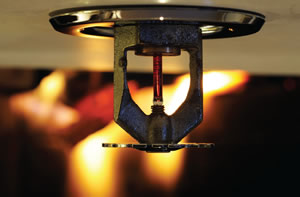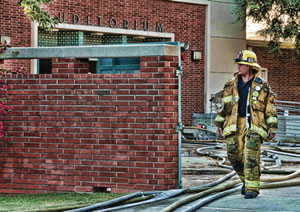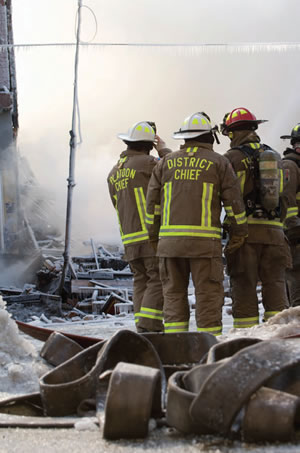Fire Safe Schools

PHOTO © SHUTTERSTOCK/JUSTIN KRAL
Michelle could not believe the nun’s instructions. The school was engulfed in flames and was filled with smoke, and Sister wanted her and her classmates to kneel and pray the rosary, the longest prayer she knew. Though badly burned, Michelle survived the deadly fire at the Our Lady of Angels Sacred Hearts School fire (in Chicago, Dec. 1, 1958) by jumping out of a third floor window. The horrible ordeal for Michelle is recounted in her book, “The Fire that Will Not Die.” Though Michelle’s school conducted one fire drill each month, staff at the school had accidently been drilled to die. Tragically, the same deadly approach is still in use by most American schools today.
From the moment of ignition, there is the potential of a major disaster with mass casualty loss of life in many school fires. The best defense against injury or possible loss of life lies in a strong fire prevention and life safety program that includes a robust fire inspection program supported by a culture of safety, empowerment and a research based drill approach.

PHOTO © CHRIS YARZAB
Avoiding Disaster. Currently, words like “school safety” conjure up thoughts of violence. But another, very important, component of school safety involves fire prevention. The best defense against injury or possible loss of life lies in a strong fire prevention and life safety program. The program must include a fire inspection program supported by a culture of safety, empowerment and a research-based drill approach. That, combined with prevention training, warning systems and research-based drill processes, can considerably reduce the potential for mass casualty loss of life.
This means drills should require individual staff to make the decision to initiate an evacuation. We should also be concerned that fire safety along with traffic safety, playground safety, preparedness for common medical emergencies and other life-safety issues has been increasingly taking a back seat to active shooter preparedness. When we consider that hundreds of students and staff have been killed in mass casualty fires, it could be dangerous to assume that other incidents of this cannot occur in modern schools.
The work of top experts including Dr. Gary Klein, author of “Sources of Power — How People Make Decisions”, Gavin De Becker, author of “The Gift of Fear — And Other Survival Signals that Protect us From Violence”, and Amanda Ripley, author of “Unthinkable — Who Survives Disasters and Why”, demonstrates that people often can and often do perform amazingly well under life and death conditions — when they are properly prepared. The problem is, we can easily and inadvertently predispose people to function poorly in emergencies if we ignore the hard-learned lessons of time.
For example, in the extensive research for a new book “Staying Alive — How to Act Fast and Survive Deadly Encounters”, we found that decades of fire science research demonstrates that it is extremely dangerous for groups of people to try to run through the same exit pathways inside buildings during an emergency. When groups of people run inside buildings, they may jam exit doorways, slowing evacuations and sometimes causing additional deaths by trampling. Six hundred people died in this manner in the Iroquois Theater fire in Chicago. Several current active-shooter-response training programs teach students and staff to run when they hear the sound of gunfire, in direct conflict with this large body of research. This is not the only example of current trends that are counter to research.
Fire can occur in a school building at any time. Though we have been spared any mass-casualty school fire in the United States since that fateful day in 1958, there have been some very close near misses. In one recent incident, fire officials felt that more than 2,000 staff and students were almost killed in a school fire.
Though fire codes and technologies have improved dramatically, it is reckless to presume that mass-casualty school fires are a thing of the past. This is especially true when we consider that fire has repeatedly been used as a weapon for school attacks in the United States and abroad. The 1958 school attack killed more students and staff than every K-12 active-shooter incident in the United States from 1998 to the time of this writing — combined.
Evaluation of K-12 active-shooter incidents, using the United States Department of Homeland Security definition of active-shooter incidents, reveals that 67 students and school employees have been murdered in active-shooter incidents on school property from 1998 to the present. Though these deaths are shocking tragedies, we should not forget that fire has repeatedly been successfully used as a mass-casualty weapon for K-12 school attacks in the United States, Nigeria, Germany and China. The potential for fire to again be used as a weapon in conjunction with firearms or other weapons is quite real, as we have seen in other attacks in the United States and other countries.

PHOTO © JOE BIAFORE
Perhaps one of the biggest tragedies is that most of our nation’s K-12 schools still conduct drills in the same manner as Michelle’s school did. Just as importantly, 1958 fire drills do not impress upon school employees the importance of fire safety. This becomes a missed opportunity to create a positive culture of not only effective fire safety, but improved emergency preparedness as well.
While a robust fire inspection and fire prevention awareness program is appropriate for K-12 schools, our analysts still find significant fire hazards in schools with some of the most impressive fire inspection programs in the nation. Over the past decade, our analysts have helped assess more than 6,000 public, private, charter, independent and parochial schools. We have found that the safest schools are those where an annual school safety assessment process is combined with drill processes that require staff to make the decision to initiate an evacuation based on a scenario, just as they would have to do in a real fire. This approach forces school staff to directly confront the reality that they may be the one staff member who has the opportunity to save lives in an emergency.
In 1958, fire drills were taken very seriously at the Our Lady of Angels Sacred Hearts School. Unfortunately, administrators at the school did not have the benefits of the research on life-and-death decision-making that we have today. As with far too many schools today, the fire drills at the school were always initiated by an administrator pulling the fire alarm, accidentally conditioning staff that someone else would activate the fire alarm. When the fire was detected, precious minutes were lost while teachers looked for the principal before pulling the fire alarm. Our analysts still routinely see the same reaction in controlled simulations during school safety assessments.
Modern school drill processes based on research and evaluation require staff members, such as front office personnel, food service employees, custodians and teachers to initiate life-saving actions. This approach not only better prepares staff to take life-saving action fast enough, but significantly increases awareness of the importance of prevention measures.
By combining an effective fire inspection process, fire prevention training, robust fire prevention, suppression and warning systems with research-based drill processes, the potential for mass casualty loss of life can be reduced considerably. Research also indicates that truly effective approach to fire safety can help schools reduce the risks of death from active-shooter situations and the more common types of school crisis events that claim far more lives.
This article originally appeared in the issue of .